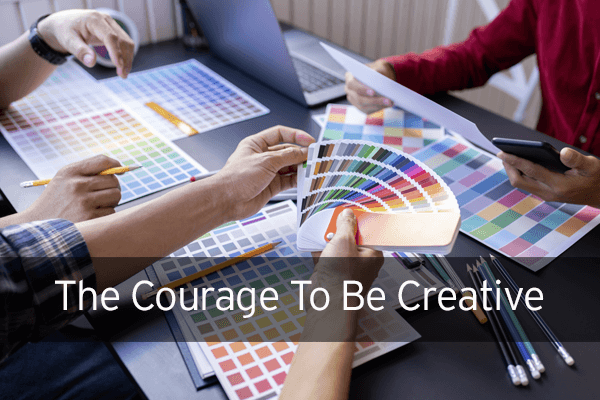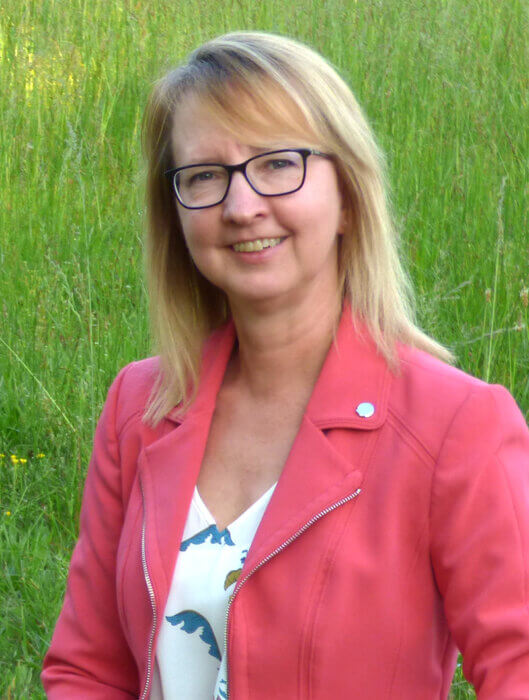Whether we’re talking about a workplace or a person, being creative elevates the impact we have in the world. Creativity, what some might call the intersection of imagination and intellect, propels innovation and society at large. Yet, allowing ourselves and our organizations to be fully creative takes quite a bit of nerve doesn’t it? New and useful ideas are often viewed with skepticism at first. Change is hard for humans as well as organizations, so welcoming something new and novel does not come naturally. But if we deny our creativity and shy away from innovation, growth will not come easy, if at all.
Facing our own fears of failure, ridicule, and ambiguity takes courage. The same is true for an organization. Leadership often takes the path of less risk, influenced certainly by the risk tolerance of the board of directors. What does it take to face those fears? To have the courage to be creative?
Benefits of a creative workplace
Let’s first sing the praises of creativity. Why even face those fears? What benefits come from being creative?
1 – It’s a differentiator
Creativity is often defined as producing new and useful ideas. New and useful ideas in the financial industry equate to products and services which better serve your members and potential members. Not just the same old products and services, but new and useful. By better serving your target audience, your credit union will rise above the noise (all the other traditional and fintech organizations).
A lower rate is NOT a new and useful idea. It will not help you differentiate. Someone else will just get louder with a lower rate of their own.
So what is a new and novel idea in the financial space? Take a look at how Chase opens community centers in underserved areas. Those centers include banking services, but with non-traditional bank staff. Instead of tellers, they encourage financial well-being with home-buying advice, business mentors, and community managers who engage in outreach. Chase has seen great success with this approach, helping them rise above the noise.
2 – More engaged employees
Studies show (here’s one) higher levels of creativity are found in employees who enjoy the process of solving problems (intrinsic motivation) AND receive something for their results (extrinsic motivation). Sounds like an engaged employee too, right? We’ve all seen this in action – an employee who loves their job is one who enjoys the process of solving whatever problems are part of their particular job. Creativity isn’t just regulated to the Marketing staff. Whether it be the accounting process, helping a customer through a sticky situation, fixing a staffer’s computer, guiding a staffer through a training exercise, these are all opportunities to be creative, to solve a problem using imagination and intellect. Then pair that with receiving appropriate external rewards and you’ve got engaged employees. These external rewards can be as simple as a pat on the back, a meaningful ‘thank you’ from a manager, – whatever pulls weight for that individual. So when your workplace encourages autonomy in solving problems then acknowledges those solutions, you’ll get more creative, innovative solutions and a more engaged employee in tandem.
3 – More resilient
Creative workplaces are more comfortable with ambiguity, weathering uncertain situations more effectively. How? Well, the creative process has us spending quite a bit of time in gray areas while we explore and test. The process includes trying new ideas, watching some fail & others succeed, all while keeping a measured perspective. We work through the process, moving towards a solid solution, knowing one (or several) is on the other side of that uncertainty. So when unexpected challenges arise, those who are used to dealing with this uncertainty will be more confident than those who have less experience with ambiguity.
Facing fear
Being creative takes quite a bit of courage. For both the individual AND the organization. Many businesses, such as financial institutions are risk averse. The boards are more concerned about just maintaining a steady presence than they are about long-term growth. Testing, experimenting, even failing a time or two in the name of innovation, are typically frowned upon. No one wants to rock the boat. The fear of making a ripple – even to put an oar in the water – dampens innovation quickly.
For individuals, many staffers might have great ideas, but they keep them close to the vest uncertain of what might happen if they share them. And then others might operate from a fear mindset – so afraid of any new and untested idea they don’t allow their minds to even explore alternative approaches. These people often have a pessimistic outlook in general – finding it easier to go with bitterness and cynicism than to have hope and faith for growing.
I have a client who has marketing staffers, yet she turns to me for creative services as her crew “isn’t very creative.” To see if we could improve the internal situation, we did a creativity workshop together. I introduced exercises and frameworks for idea generation, but even those tools didn’t help this one particular staffer.
Then over lunch with my contact some time later, I learned more about how this one employee operates. The connection clicked – the negative mindset this person has makes it so much harder for her to imagine positive possibilities.
Creativity is all about a fresh approach to whatever problem is in front of us. But if we’re so afraid of change, if we have a hard time seeing positive outcomes, then how can we even open ourselves to new and novel?
Fear of change as well as fear of failure – whether it’s at the organizational or individual level – are real challenges to fostering a creative culture. But these fears can be addressed, managed, and even faced. For isn’t that the definition of courage? Feeling the fear but doing it anyway?
So how can we encourage our employees to be courageous in their creativity?
1-Build Trust
This topic alone fills many a business book, so I won’t pretend one paragraph will fix your trust issues. But at the core of trust is honoring our commitments, as well as being open, authentic, and caring in our actions and communications. When a staffer feels the workplace is a safe place to share their ideas, they’ll begin to do so.
2-Embrace Experimentation
Many companies like Google, 3M, and Atlassian have used the side project approach to encourage experimentation. The Post-It Note was a side project development – created when 3M supported staffers to use about 15% of their time pursuing new and novel ideas without fear of repercussions if the project didn’t pan out. What could your organization do to encourage experimentation? It may not go so far as the side project approach, but think of how you can embrace ‘failure’. More lessons come from failed tests than playing it safe. Take a look at how your organization might be more encouraging when it comes to new ideas.
3-Energize with Exercise
Just like we need physical exercise for a strong body, we need mental exercises to strengthen our idea muscles. Creative exercises provide a sense of structure and focus for groups and individuals alike. As an exercise unfolds, our brains make new connections, wander into new territories, and help us see situations in a new light. There are many different types of exercises, but my favorites can be found in this previous article.
4-Provide Playtime
Our brains have the left side (more analytical) and the right side (more intuitive). Ideas come from both sides, but how those two express the ideas can be very different. The left side has us directly addressing the problem, say while we’re typing away at the computer or talking through ideas in a brainstorming session. The right side of the brain needs more time to make connections with all the various inputs we’ve been receiving. And it has a hard time making itself heard when the left-side is engaged. But give the left side something to do (walking, coloring, driving) and suddenly the right side has the space to ‘talk’.
I would imagine you’ve had your own “A-ha!” moments? Say when you’re in the shower or mowing the lawn? Ideas just seem to pop up. That’s the right side of the brain finally getting to raise its hand. So provide ‘playtime’ for your staffers. Encourage a walk around the building after a brainstorming session. Or have a big doodle board in a hallway. Give them space and time to listen to the right side of their brain and you’ll be fostering creativity.
5-Reward Risk
Having worked with many credit unions and community banks I see various levels of risk tolerance. It really becomes apparent as we discuss what disclosures they want on their marketing and advertising materials. Each organization has its own approach – what risk they feel comfortable accepting. Let’s apply that to idea generation as well!
If you want your organization to be innovative and leading edge, craft guidelines for how you’ll encourage appropriate risk-taking. If your organization would prefer to be more mainstream and go with the flow, then maybe new and novel ideas don’t really have a place in your system. But once you decide on your acceptable level of risk, reward those who step up and take it. This doesn’t mean every idea gets implemented, but it does mean those who show the courage to be creative are acknowledged and celebrated in whatever way makes them feel seen and appreciated.
Does your organization have what it takes to be creative & innovative? I certainly hope so. Those who do will be stronger, more resilient, and better serve their customers and their community.


